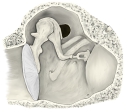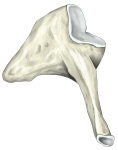キヌタ骨 ( きぬたこつ、英:incus )
|
|
The incus or anvil is a bone in the middle ear. The anvil-shaped small bone is one of three ossicles in the middle ear. The incus receives vibrations from the malleus, to which it is connected laterally, and transmits these to the stapes medially. The incus is so-called because of its resemblance to an anvil (Latin: Incus).
【Structure】
See also: Ossicles
The incus is the second of the ossicles, three bones in the middle ear which act to transmit sound. It is shaped like an anvil, and has a long and short crus extending from the body, which articulates with the malleus.: 862 The short crus attaches to the posterior ligament of the incus. The long crus articulates with the stirrup at the lenticular process.
The superior ligament of the incus attaches at the body of the incus to the roof of the tympanic cavity.
Main article: Hearing
Vibrations in the middle ear are received via the tympanic membrane. The malleus, resting on the membrane, conveys vibrations to the incus. This in turn conveys vibrations to the stapes.
【 語 句 】
・anvil:鉄床 ・middle ear:中耳 ・ossicles:小骨 ・malleus:ツチ骨 ・stapes:アブミ骨 ・resemblance:類似 ・crus:脚 ・articulate with~:~関節する ・stirrup:アブミ骨 ・lenticular process:豆状突起 ・tympanic cavity:鼓室 ・tympanic membrane:鼓膜 ・convey:伝達する

















